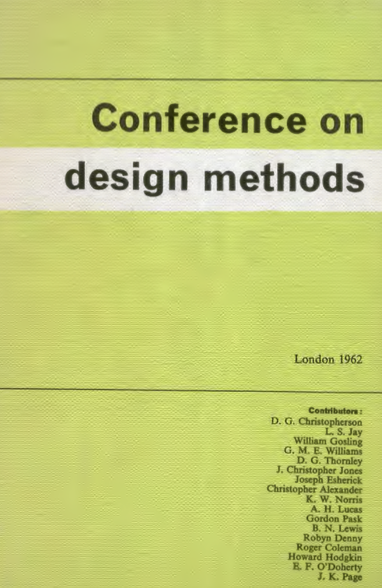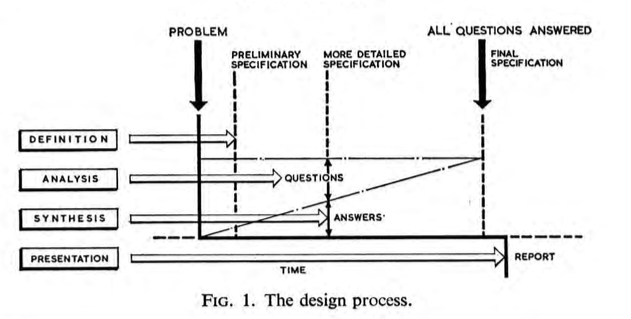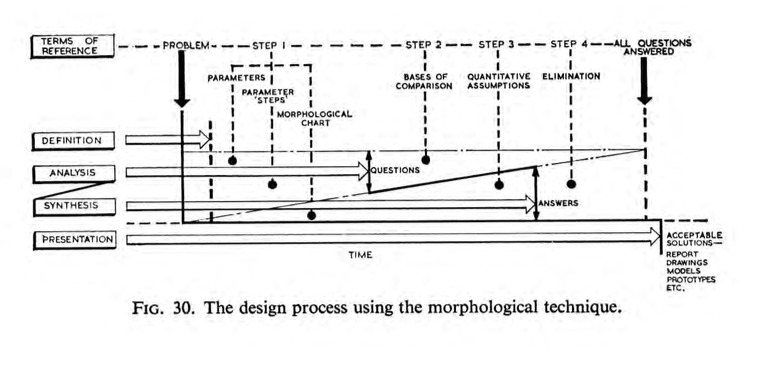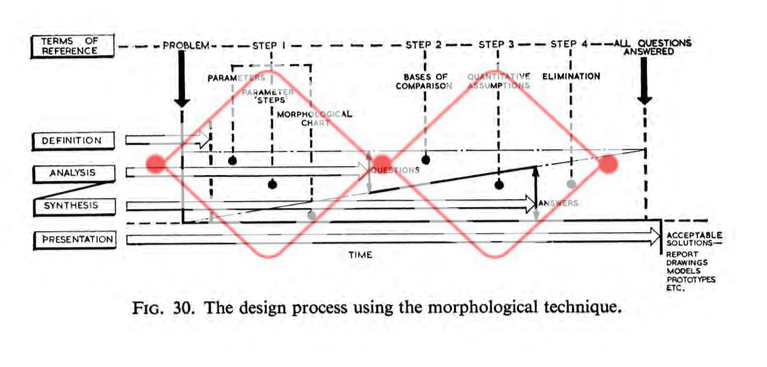The design process has been described, modelled and designed quite a bit since one of the landmarks in the history of design studies, the 1962 conference at Imperial College on design methods.

Jones, J.C. & Thorney, D.G. (editors) (1963) Conference of design methods. Papers presented at the Conference on Systematic and Intuitive Methods in Engineering, Industrial Design. Architecture and Communications, London, September 1962, Oxford: Pergamon Press
An example of a kind of designing of the design process is quite clearly found in a paper given by Ken Norris (1963) at the Imperial College conference. Norris cites the morphological method of Fritz Zwicky (1951) to demonstrate “the application of engineering first principles to take a fresh look at some old problems and to establish a novel approach to new ones.” Zwicky’s method was originally published in the Journal of American Rocket Society which suggests that, at the time, a morphological approach to design was something approaching rocket science, a notion underlined by the reputation of Norris’ engineering company who designed rocket powered cars.
Here then, at one of the earliest design conferences, is a world renowned engineer explaining his approach to design and how what he calls the “normal process of designing”, shown here in his Fig 1 (Norris, 1962:118),

might be enhanced by adopting a methodical approach to the design process that is intended to support a “very conscious way of carrying [it] out” (Norris, 1962:118). His revised model of the process explicitly recognises a number of additional steps through which the design engineer will pass to reach an acceptable solution that answers all the questions posed by the problem, shown below in his Figure 30 (Norris, 1962:139).

This model is a single example from any number. Nigel Cross has some more (1989) which he divides into descriptive ones, that show how design is seen to be done, and prescriptive ones, that show how design should be done better. Cross includes a model from 1985 by French (Cross, 1989:21), a 1984 model by Archer (ibid:25), a 1984 model by Pahl and Beitz (ibid:27), VDI2221 (ibid:28) and March (ibid:30). Out of this long and growing pedigree Norris is notable for three reasons.
Firstly, Norris provides the two simple representations of before and after that allow a simple comparison of his own designs on design. The detail of these differences is not so important. Intervening years have produced many refinements as seen already by those outlined by Cross above (at almost exactly the mid-point between 1962 and 2016) and can are further developed, for example, in the pages of most issues of Design Studies, the Journal of the Design Research Society. But if we just take Norris’ two diagrams at face value we can isolate the changes he has introduced. These are two main interventions: the extension of the original specification stage to provide for the generation of more candidate solutions – Norris hopes for “all possible solutions” at this stage; and the extension into a more detailed specification stage that allows for those all of those solutions to reviewed as the most acceptable one is identified. The model turns a simple linear design narrative into one that creates a number of divergent propositions that converge onto a final solution. This model remains current, for example in the Design Council’s ‘double diamond‘ design process model.
 Norris’ final amendment is to the list of what kind of questions the design process can answer. To the “report” of the original model he adds a number of additional projects that include “drawings” and “prototypes” to suggest an iterative approach to design and an “etc.” that might mean the model could be applied to anything.
Norris’ final amendment is to the list of what kind of questions the design process can answer. To the “report” of the original model he adds a number of additional projects that include “drawings” and “prototypes” to suggest an iterative approach to design and an “etc.” that might mean the model could be applied to anything.
Secondly, the model is also notable for being the clearest visual example in the proceedings of the landmark 1962 conference on design methods. This makes it a de facto landmark model of the design process. It should be noted however that at the same conference Christopher Alexander described his method of designing an Indian village in an early report of his Notes on the Synthesis of Form (Alexander, 1964) and various other speakers were proposing design methods as ways of approaching town planning, education, group communication and, via the connection between design and creativity, the fine art practice of a young Howard Hodgkin. Despite this the conference is generally considered to be the point at which design got scientific (Cross, 2001).
Thirdly is the status of the speaker. Here is an engineer who designed a car that had already set seven world speed records and whose driver was awarded the CBE in recognition of these achievements. At the time of the conference Norris was in the middle of developing Bluebird Proteus CN7, a contender for the land speed record, that he used as an example in the paper referred to. Does this kind of material, and this kind of speaker, make it onto conference schedules any more?
References
Alexander, C., (1964) Notes on the Synthesis of Form, London:Harvard
Cross, N., (2001) Designerly Ways of Knowing: Design Discipline Versus Design Science. Design Issues, 17(3), pp.49–55.
Norris, K., (1963) The Morphological Approach to Engineering Design, Conference of design methods, Oxford:Pergamon
Zwicky, F., (1951) Tasks we face. Journal of American Rocket Society, 84 (March 1951)